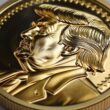Backdating Allegations
English artist Damien Hirst is facing increased scrutiny after reportedly backdating over 1,000 pieces of art from his NFT project “The Currency,” as reported by The Guardian. The artist, renowned for his works featuring preserved animals, has allegedly misrepresented the creation dates of approximately 10% of the 10,000 physical paintings associated with “The Currency,” each tied to a corresponding NFT.
Initially launched in 2021 and sold for $2000, Hirst claimed that all the physical paintings linked to the NFT project were crafted by hand in 2016. However, sources revealed to The Guardian that these dotted paintings were actually mass-produced by a team of artists between 2018 and 2019, utilizing a production line akin to that of Henry Ford.
“It was very, very tedious,” said one source to The Guardian. “There were loads of sheets on these tables, and they were quite low so you had to bend down to do the spots. After a while, some people were getting repetitive strain injuries.”
Footage obtained from Hirst’s studio in 2019 and validated by media sources substantiates the allegations made against him. Hirst’s legal representatives did not refute the accusations, explaining that the 2016 date signifies the conceptual origin of “The Currency” rather than the actual production dates of the paintings.
Consequences and Response
Buyers of “The Currency” were given the option to retain either the physical artwork or its digital twin but not both. In a controversial move in 2022, Hirst opted to burn the physical versions for those who chose the NFT, effectively translating the value of each painting into the digital realm.
“A lot of people think I’m burning millions of dollars of art but I’m not,” Hirst clarified to the BBC. “I’m completing the transformation of these physical artworks into NFTs by burning the physical versions.”
Backdating, the practice of assigning an incorrect creation date to a piece, is widely disapproved within the art community. This isn’t the first instance of Hirst facing allegations of misdating artwork, as a prior exposé by The Guardian disclosed that three of his formaldehyde sculptures supposedly from the 1990s were crafted in 2017.
If these claims are validated, they could substantially harm Hirst’s reputation, cast doubt on the authenticity of his creations, and potentially devalue his NFT project.
















